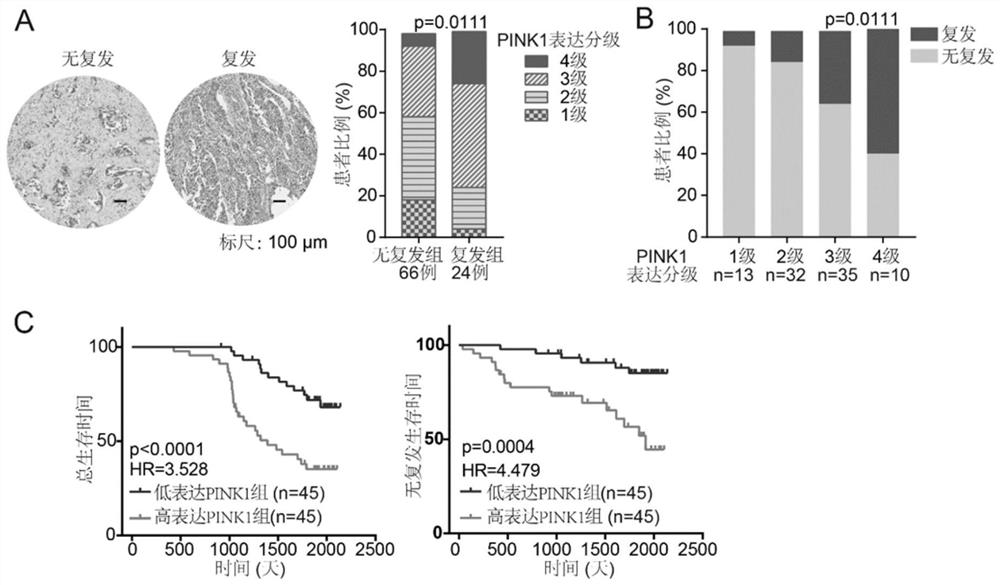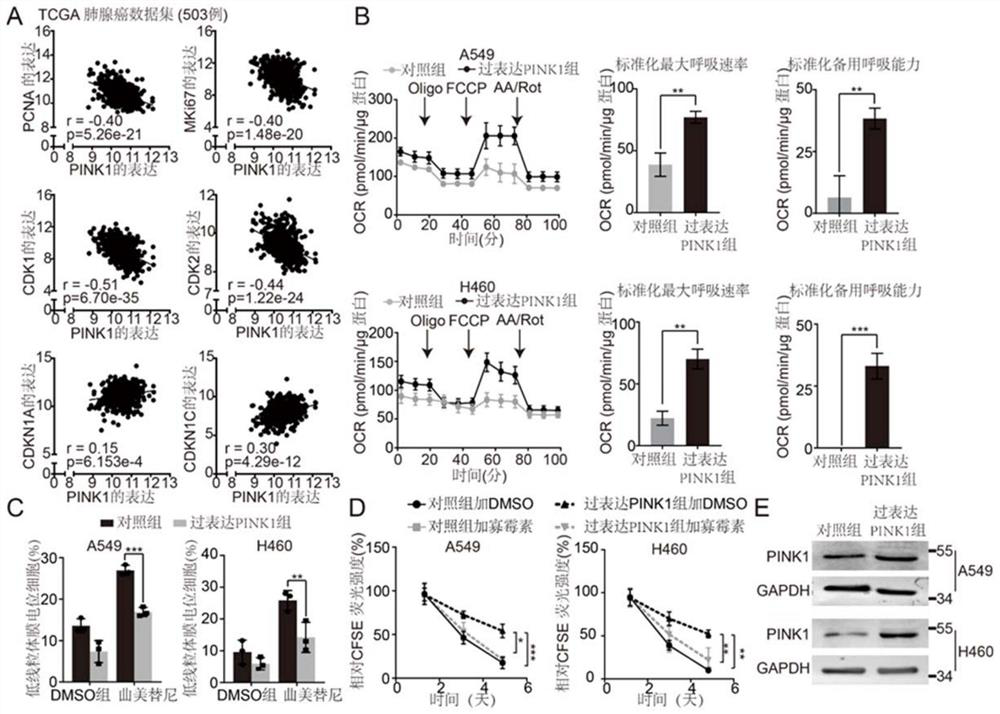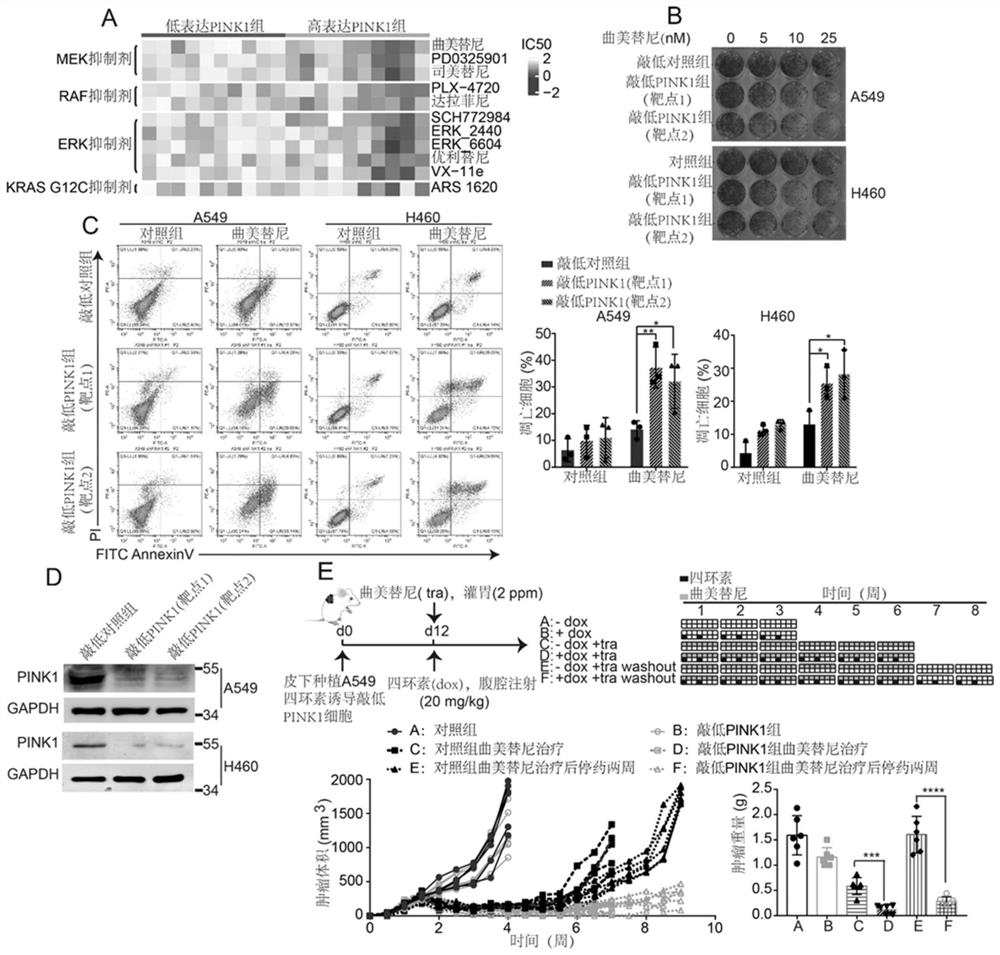Application of PINK1 as marker for predicting sensitivity of lung adenocarcinoma to MAPK inhibitor and recurrence of lung adenocarcinoma
An inhibitor and sensitive technology, applied in the field of biomedical technology and biomedicine, can solve the problems of MAPK pathway inhibitor drug resistance, and achieve the effect of improving tumor dormancy and recurrence, preventing tumor recurrence, and avoiding drug resistance and tumor recurrence.
- Summary
- Abstract
- Description
- Claims
- Application Information
AI Technical Summary
Problems solved by technology
Method used
Image
Examples
Embodiment 1
[0068] Example 1 Correlation between the expression of PINK1 and tumor recurrence in patients with lung adenocarcinoma
[0069] In order to verify the relationship between the expression of PINK1 and the recurrence and survival prognosis of patients with lung adenocarcinoma, this study used the PINK1 antibody (23274-1-AP, proteintect) to perform immunohistochemistry on tissue chips (Shanghai Xinchao Biotechnology Co., Ltd.) of 90 patients with lung adenocarcinoma. According to the staining intensity and positive rate of PINK1, the expression grade of PINK1 was judged. Divided into 4 grades: grade 1 represents no coloration, grade 2 represents weak positive, grade 3 represents positive, and grade 4 represents strong positive. The patients were divided into groups according to the recurrence status, and the expression of PINK1 in the tumor tissues of the two groups of patients was counted.
[0070] The statistical results showed that the expression of PINK1 protein was higher i...
Embodiment 2
[0071] Example 2 Study on the effect of PINK1 expression on the dormancy of lung adenocarcinoma at the cell level
[0072] 1. Correlation analysis between PINK1 expression and cell cycle regulation gene expression
[0073] The data comes from the RNA sequencing data of 503 cases of lung adenocarcinoma in the TCGA database, and the expression of the PINK1 gene and the expression of cell cycle regulatory genes are obtained, including the genes PCNA, MKi67, CDK1, and CDK2 that positively regulate the cell cycle, and the genes that negatively regulate the cell cycle. Genes such as CDKN1A, CDKN1C.
[0074] The results were tested by Pearson, and the results showed that the expression of PINK1 gene was significantly positively correlated with the expression of negatively regulated genes of cell cycle, and was significantly negatively correlated with the expression of positively regulated genes of cell cycle ( figure 2 A), which shows that PINK1 is a negative regulator of the cell ...
Embodiment 3
[0104] Example 3 Study on the effect of PINK1 expression on the efficacy of MAPK pathway inhibitors in the treatment of lung adenocarcinoma at the cell level
[0105] 1. Correlation analysis between the expression of PINK1 and the sensitivity of lung adenocarcinoma cell lines to MAPK pathway inhibitors The data came from the Genomics of drug sensitivity in cancer (GDSC) database. Expression of the PINK1 gene in lung adenocarcinoma cell lines. The lung adenocarcinoma cell lines were divided into two groups according to PINK1 expression: the top 20% of PINK1 expression cells, i.e. high PINK1 expressing cells, and the post PINK1 expression 20% cells, i.e. low PINK1 expressing cells. The median lethal concentration data (IC50) of 11 MAPK pathway inhibitors on lung adenocarcinoma cell lines were obtained from this database. Comparing the differences in the sensitivity of cells to MAPK pathway inhibitors between the high-expression PINK1 group and the low-expression PINK1 group, th...
PUM
 Login to View More
Login to View More Abstract
Description
Claims
Application Information
 Login to View More
Login to View More - R&D
- Intellectual Property
- Life Sciences
- Materials
- Tech Scout
- Unparalleled Data Quality
- Higher Quality Content
- 60% Fewer Hallucinations
Browse by: Latest US Patents, China's latest patents, Technical Efficacy Thesaurus, Application Domain, Technology Topic, Popular Technical Reports.
© 2025 PatSnap. All rights reserved.Legal|Privacy policy|Modern Slavery Act Transparency Statement|Sitemap|About US| Contact US: help@patsnap.com



